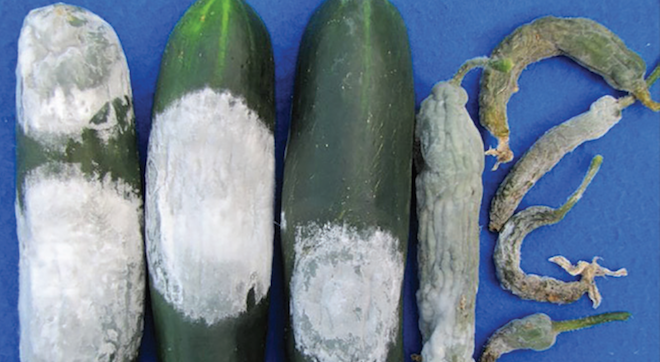

Oct 6, 2021Pythium in cucurbits: Temperature decides species
There are more than 300 species of pythium. Many don’t harm plants, but many do, and cucurbits are particularly susceptible. New research at Clemson University has identified some of the pythium species that most commonly cause root and stem rot in cucurbits. This information can help researchers screen cultivars for resistance and may help growers tailor control programs.
Clemson’s three-year study looked at four representative cucurbits and evaluated which pythium species were most capable of causing the disease.
These were the watermelon variety Sugar Baby, the cucumber Marketmore 76, the Hubbard squash Golden Hubbard and an unnamed cultivar of bottle gourd. Bottle gourd and winter squash rootstocks are often used to graft watermelon – by far the cucurbit with the largest acreage in South Carolina.


“Cucumbers are supposed to be the most susceptible to pythium, but we were seeing as much or more damping off on watermelon,” said Anthony Keinath, research and Extension pathologist in Clemson’s Plant and Environmental Sciences Department.
The Clemson study collected 563 pythium samples from eight fields, and the species were identified in the laboratory.
The pythium species P. spinosum, P. myriotylum, P. irregulare, and P. aphanidermatum were the species most commonly found to be causing stem and root rot in the four cucurbits.
“These isolates were found in every field, every year and on every cucurbit host,” said Sean Toporek, graduate researcher at Clemson University.
Pythium samples were collected in March, May, July, September and November, and there was a clear difference in the isolates found by season. In the cooler months of March and November, P. spinosum – and to a lesser extent P. irregulare – were the predominant isolates found. In the warmer months of May and September, P. myriotylum and P. aphanidermatum were more predominant, although the other two species were also found.
In the warmest month – July – nearly all of the isolates were P. myriotylum and P. aphanidermatum.
“The hottest months only had the species most suited for warm weather,” Keinath said. “I was impressed by how clearly the results followed temperature.”
Researchers also evaluated the pythium species’ sensitivity to fungicides. All of the four main isolates were sensitive to mefenoxam (Ridomil Gold) and propamocarb (Previcur Flex).
Mefenoxam was more effective on the cool-season pythium species. Propamocarb was more effective on the warm-season species. This gives mefenoxam an advantage in early spring plantings into cooler soil, and propamocarb an advantage for later spring plantings into warmer soil.
However, P. spinosum, P. myriotylum, P. irregulare and P. aphanidermatum were all insensitive to the new fungicide oxathiapiprolin (Orondis). P. ultimum, a pythium species only found occasionally in the study, was most sensitive to the new fungicide.
“P. ultimum is the most virulent pythium species on many crops,” Keinath said.
It is important in cucurbits, but has a less significant distribution than other pythium species. P. ultimum is a cool-season species and is generally more common in northern states. Oxathiapiprolin is the best fit only if a grower has P. ultimum.
The Clemson study identified grafting as useful in controlling pythium. Researchers observed robust resistance when the seedless watermelon cultivar Tri-X 313 was grafted on to hybrid squash rootstocks – even at high inoculum levels.


Clemson researchers also compared the pythium species found in conventional and organically managed fields, but the results were inconsistent.
“In most of the years, there was no real difference,” Toporek said.
South Carolina is warmer and wetter than many other states, which is the most favorable weather for pythium, and why South Carolina has more problems with the disease.
“Free flowing water is how pythium moves, so the more saturated the soil is, the more opportunities the zoospores have to spread,” Keinath said.
This is a real problem for watermelon.
Clemson researchers ranked five seedless watermelon varieties for susceptibility to pythium. Fascination, Captivation and Sugar Baby all had stand losses in excess of 60%. Joyride and the pollinizer SP6 had significantly lower percentages of dead plants. Estrella was the most susceptible to pythium – especially to the species P. ultimum – and in one trial had stand losses approaching 100%.
The broad management strategy to help manage root and stem rots in cucurbits is always to improve drainage.
This can be drip irrigation to precisely manage soil moisture, or raised beds with plastic mulch to repel rain and warm the soil. Cutting water furrows to drain water out from between the rows and excess water within the row can help.
Subsoiling at least once every four or five years can help with drainage in South Carolina. Most primary tillage is with a disk, and that can cause a compacted layer at disk depth. The coastal plain’s shallow topsoil on top of a clay layer also requires occasional subsoiling.
Delaying the watermelon transplanting date trying to miss pythium infestations may not always work because of the warm season and cool season pythium isolates.
“You could miss one group, but you’re not going to miss both,” Keinath said.
An integrated pest management program can be very useful to growers. It’s important to remember a symptom of pythium on cucurbits is not just root rot, but also stem rot.
“Growers need to know which disease they’re dealing with,” Keinath said. “Pythium will show up on early plants. Phytophthora shows up on older plants.”
Clemson’s research on pythium was presented at last winter’s Mid-Atlantic Fruit & Vegetable Convention, which was held virtually.
— Dean Peterson, VGN correspondent; Photo at top: Pythium in cucurbits. Photo courtesy of Clemson University.














